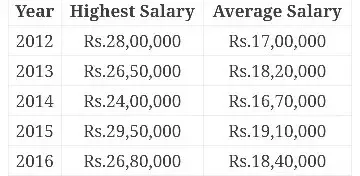Exploring India’s Average Monthly Salary Trends
India, a burgeoning economy with a diverse workforce, exhibits intriguing patterns in its average monthly salary trends. From the bustling urban centers to the tranquil rural landscapes, income dynamics vary significantly, reflecting the intricate interplay of various socio-economic factors.
Factors Influencing India’s Average Monthly Salary
1. Economic Landscape
India’s economic trajectory, characterized by phases of rapid growth and occasional slowdowns, profoundly influences salary trends. Industries such as Information Technology (IT), manufacturing, and services often dictate the pace of salary increments.
2. Regional Disparities
The geographical diversity of India results in pronounced regional variations in average monthly salaries. Metropolises like Mumbai, Delhi, and Bengaluru boast higher average salaries due to their status as economic hubs, while rural areas often struggle with lower income levels.
3. Education and Skill Levels
Education and skill levels play a pivotal role in determining individual earning potential. Professions requiring specialized skills or advanced degrees command higher salaries, reflecting the value placed on expertise in the job market.

4. Cost of Living
The cost of living index directly impacts salary structures, especially in metropolitan areas where housing, transportation, and other expenses are relatively high. Employers often adjust salaries to ensure employees maintain a reasonable standard of living.
Implications for Individuals and the Economy
Understanding India’s average monthly salary trends is crucial for both individuals and policymakers.
1. Financial Planning
For individuals, knowledge of salary trends aids in financial planning, budgeting, and setting realistic goals. It allows employees to negotiate better compensation packages and make informed career decisions.
2. Socio-economic Development
From a macroeconomic perspective, rising average salaries signify improved standards of living and socio-economic development. However, persistent disparities in income distribution highlight the need for targeted interventions to ensure inclusive growth.
3. Talent Retention and Attraction
Competitive salary packages are essential for attracting and retaining top talent, driving innovation and productivity in various sectors. Employers must align their compensation strategies with industry standards to remain competitive in the talent market.
4. Policy Formulation
Policymakers can leverage insights from salary trends to formulate policies promoting equitable economic growth. Investments in education, skill development, and infrastructure are instrumental in bridging regional disparities and enhancing overall productivity.
Conclusion
India’s average monthly salary trends offer a fascinating glimpse into the complex dynamics of its evolving economy. By analyzing these trends, individuals can make informed career choices, while policymakers can devise strategies to foster inclusive growth and prosperity for all segments of society. As India continues on its path of development, understanding and addressing salary disparities will remain paramount in building a more equitable and prosperous future.



